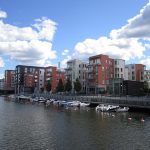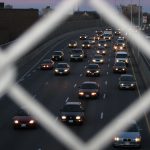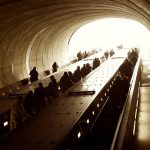What makes a successful Bus Rapid Transit line?
Thirty-one million-plus people around the world make their way each day via BRT, or bus rapid transit. As The City Fix reports, over the last 15 years a “BRT boom” has meant a major move in favor of sustainable transport. New research recently debuted at the Transforming Transportation 2015 conference investigates how the built environment of a city impacts BRT ridership, station by station, in certain Latin American cities.

BRT projects are building sustainable capacity in Latin America, and having an impact on the built environment. Image from Mariordo59.
The study, led by Erik Vergel-Tovar, a PhD candidate at the University of North Carolina at Chapel Hill, and Madeline Brozen, assistant director and complete streets initiative manager at UCLA’s Institute of Transportation Studies, explored links between BRT ridership and built environment data at 120 BRT stations in seven Latin American cities. (BRT was premiered in Latin America over 40 years ago.) The results? The built environment does play a meaningful role in BRT ridership… and so do, perhaps unexpectedly, land use and active transport infrastructure.
The design of a city — not just its population — helps determine whether its residents will ride the BRT. As Vergel-Tovar explains, “Conventional wisdom says that population density is the primary determinant of BRT ridership. However, high-rise developments, mixed land uses, non-motorized transport infrastructure, and public facilities—like hospitals, libraries, markets, plazas, and churches—surrounding BRT stations also play an important role explaining ridership.” This translates into several important takeaways for designing BRT systems:
- A choice spot for a BRT would be an area including the “strong presence of public facilities in combination with industrial-commercial developments mixed with some residential land uses”
- BRT lines that link dense, multi-family developments with commuter destinations (think universities or business areas, for example) stand to gain from pedestrian-friendly public spaces and access to businesses and offices
- The built environment can also support historic centers provided there is a “strong pedestrian infrastructure,” with linked public spaces, access to public facilities and commercial land use
- High-rise, multi-family buildings — in tandem with commercial land use and “moderately high” population density — can positively contribute to the success of a BRT line
- BRT stations in low-income or informal settlement areas experience higher ridership when providing particular benefits, including mixed land use, accessible public facilities, and “adequate” pedestrian infrastructure, for their riders
- BRT terminals may experience boosts in ridership if they serve as “nodes” of greater projects, such as “high-rise and mixed land use developments that are connected with non-motorized transport infrastructure.”
These are significant insights for agencies looking to launch, expand or refine their BRT systems. “BRT stations can expect a positive change in ridership if the built environment around BRT stations has these features. A diverse mixture of land uses—like tall, multi-family residences, commercial businesses, and offices concentrated around stations—has been shown to strengthen ridership,” Vergel-Tovar notes. “Local governments should consider not only the physical built environment features discussed here, but also how these elements can be combined to create more transit-oriented and pedestrian-friendly environments.”
The state of BRT in the U.S. is less promising. Nashville, Tennessee’s plan to build its very first line, a 7-mile busway that would connect East Nashville to the city’s downtown area as well as western areas of the city, was killed earlier this year thanks to a group supported in part by the Koch brothers. (Learn more about why the billionaire siblings want to take down BRT in this compelling piece.) Yet Obama’s new transportation budget offers a sliver of hope: if passed intact, the plan stipulates a jump in transit funding ($123 billion over six years) for projects including BRT.
Related Posts
Category: Transportation

















